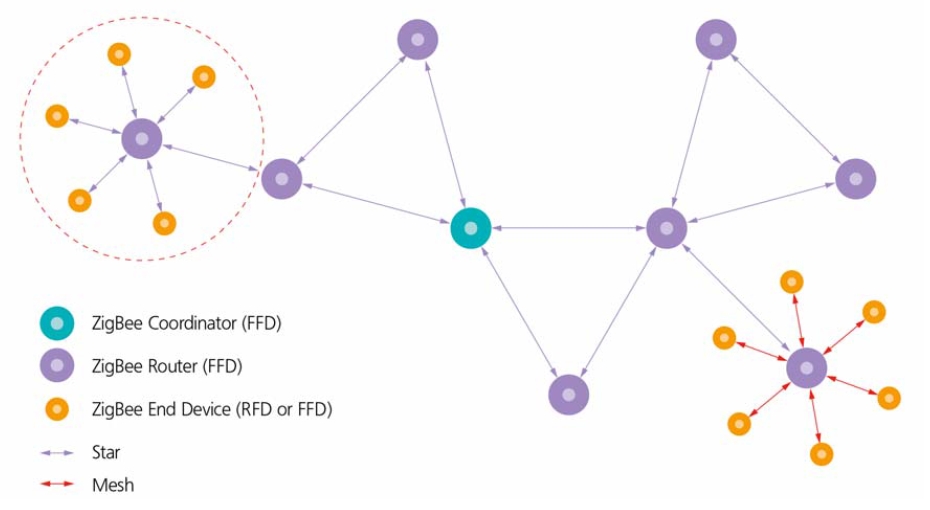ZigBee
ZigBee (IEEE 802.15.4) is a suite of high level communication protocols using small, low-power digital radio signals to allow any enabled device to communicate wirelessly. Depending on the manufacturer, ZigBee nodes communicate at relatively low-power which limits their range to approximately 10 m to 30 m indoors but several hundred metres outdoors depending on line-ofsight and environmental conditions.
ZigBee devices can be programmed to operate in three different modes; coordinator, router and end device. This enables ZigBee devices to form a complex network of mesh and routing nodes similar to how the Internet operates. ZigBee devices are equipped with radio transceivers through which they discover each other and then a master unit applies an appropriate addressing scheme. This allows ZigBee networks to daisy chain devices through mesh network routing (Multi-Hop Ad Hoc Network) [71], [72] and hence span larger distances than a single module’s radio range.
ZigBee is designed to offer low power consumption, low cost (device, installation and
maintenance), a high density of nodes per network, simple protocol and global implementation. It can go from sleep to active mode very quickly which means that average power consumption can be very low and battery life is normally over 2 years.
As a way to help reduce the cost even further the devices come in two types; Full Function Device (FFD) and Reduced Function Device (RFD). The limitation of the RFD is that it can only connect to an FFD and therefore is only suitable for star topologies. FFD’s can be both coordinators and network coordinators (peer-to-peer intermediates and central network master controllers) making them suitable for any topologies [73].
ZigBee is a more complicated protocol than Z-Wave but it can come with different profiles that pre-configure the device for specific applications such as smart energy, healthcare, building automation etc. ZigBee is currently being implemented in the rollout of smart meters across the UK.
This article was created by --BRE. It was taken from The future of electricity in domestic buildings, a review, by Andrew Williams, published in November 2014.
[edit] Find out more
[edit] Related articles on Designing Buildings Wiki
- Bluetooth.
- CAT5.
- Ethernet
- Extranet
- Glossary of electrical terms.
- ICT and Automation (ICTA) Scoping Study Report.
- In-building wireless.
- Information and communications technology.
- Internet of things.
- Local area network.
- Smart buildings.
- Smart cities.
- Smart technology.
- The future of electricity in domestic buildings.
- Wifi.
[edit] External references
- [71] Baronti P et al. Wireless sensor networks: A survey on the state of the art and the 802.15.4 and ZigBee standard. Computer Communications, vol. 30, no. 7, pp. 1655-1695, 2007.
- [72] Bruno R et al. Mesh networks: commodity multihop ad hoc networks. Communications Magazine, IEEE, vol. 43, no. 3, pp. 123-131, March 2005.
- [73] Kinney P. ZigBee Technology: Wireless Control that Simply Works. Communications Design Conference, San Jose, 2003.
Featured articles and news
RTPI leader to become new CIOB Chief Executive Officer
Dr Victoria Hills MRTPI, FICE to take over after Caroline Gumble’s departure.
Social and affordable housing, a long term plan for delivery
The “Delivering a Decade of Renewal for Social and Affordable Housing” strategy sets out future path.
A change to adoptive architecture
Effects of global weather warming on architectural detailing, material choice and human interaction.
The proposed publicly owned and backed subsidiary of Homes England, to facilitate new homes.
How big is the problem and what can we do to mitigate the effects?
Overheating guidance and tools for building designers
A number of cool guides to help with the heat.
The UK's Modern Industrial Strategy: A 10 year plan
Previous consultation criticism, current key elements and general support with some persisting reservations.
Building Safety Regulator reforms
New roles, new staff and a new fast track service pave the way for a single construction regulator.
Architectural Technologist CPDs and Communications
CIAT CPD… and how you can do it!
Cooling centres and cool spaces
Managing extreme heat in cities by directing the public to places for heat stress relief and water sources.
Winter gardens: A brief history and warm variations
Extending the season with glass in different forms and terms.
Restoring Great Yarmouth's Winter Gardens
Transforming one of the least sustainable constructions imaginable.
Construction Skills Mission Board launch sector drive
Newly formed government and industry collaboration set strategy for recruiting an additional 100,000 construction workers a year.
New Architects Code comes into effect in September 2025
ARB Architects Code of Conduct and Practice available with ongoing consultation regarding guidance.
Welsh Skills Body (Medr) launches ambitious plan
The new skills body brings together funding and regulation of tertiary education and research for the devolved nation.
Paul Gandy FCIOB announced as next CIOB President
Former Tilbury Douglas CEO takes helm.
UK Infrastructure: A 10 Year Strategy. In brief with reactions
With the National Infrastructure and Service Transformation Authority (NISTA).
























